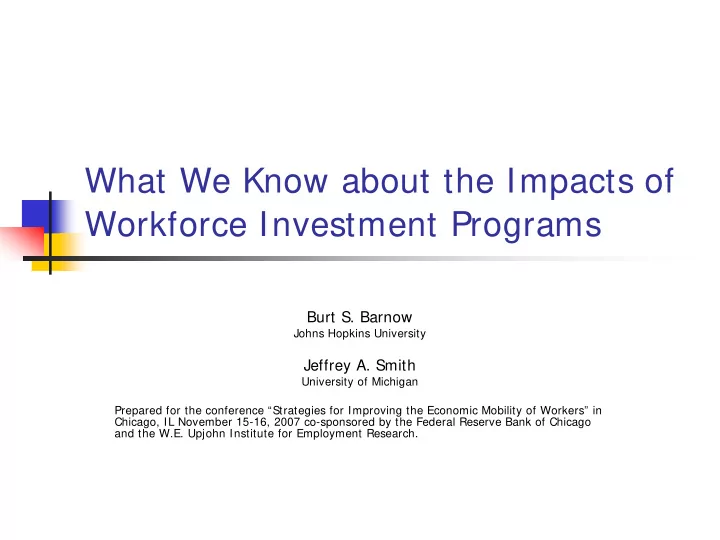

What We Know about the Impacts of Workforce Investment Programs Burt S. Barnow Johns Hopkins University Jeffrey A. Smith University of Michigan Prepared for the conference “Strategies for Improving the Economic Mobility of Workers” in Chicago, IL November 15-16, 2007 co-sponsored by the Federal Reserve Bank of Chicago and the W.E. Upjohn Institute for Employment Research.
Introduction � Focus on effectiveness of national programs � Do not emphasize econometric issues, but they influence our interpretation � Programs discussed � Mainline training programs (CETA, JTPA, WIA) � Job Corps � Employer-focused programs � Analytic Issues
A Very Brief History of Workforce Programs � Public employment programs and employment service started in 1930s � Training programs arrived in 1960s: � MDTA, 1962-1973 � CETA , 1973-1982 � JTPA, 1982-1998 � WIA, 1998-
Evaluations of Training Programs Improved Over Time � MDTA had mostly local evaluations with convenience sample comparison groups � Ashenfelter study used national data and more sophisticated methods � CETA had national sample with comparison groups drawn from CPS � Many scholars funded to conduct evaluations � Literature review by Barnow (1978) found impact estimates highly sensitive to matching and analytical approach � Advisory panel recommended that next program be evaluated with experimental design.
Evaluation of JTPA DOL conducted experiment in 16 sites in late 1980s � Good news: Random assignment assures internal validity � Bad news: These were the only sites willing to participate � National JTPA Study found statistically significant impacts of � $847 for women and $856 for men participants in first post- program year Impacts for youth were not small and not statistically significant � GAO study found treatment-control difference persisted for 5 � years, but was no longer statistically significant Mueser et al. (2007) used more recent propensity score � matching approach and found similar results for Missouri using ES registrants as comparison group
Evaluation of Job Corps Job Corps was evaluated using nonexperimental methods in 1970s and � experiment in 1990s. Job Corps successful in many respects, but not in long run: � Increased education by about 1,000 hours, roughly equal to 1 � more year of schooling Significant reduction in criminal activity in first 48 months � Increased GED and vocational certificates by 20 percentage points � In 4 th year after random assignment, earnings increased by $1,150 � or 12% In years 5-10, no earnings gain for overall sample � For youth 20-24, significant $1,000 earnings gain in year 8 and � insignificant $780 gain in year 10 Cost-benefit analysis indicates that for 10-year period, program � worthwhile for participants but not for society.
Employer-Focused Programs Programs originally relied on a “Field of Dreams” approach: if � you train them, employers will come For both JTPA and WIA states and local programs have boards � with private sector majorities Programs originally relied on a “Field of Dreams” approach: if � you train them, employers will come Over time, the system has come to recognize the importance of � training workers to meet employer needs Three types of employer-focused programs discussed: On-the- � job training, customized training, and sectoral projects
On-the-Job Training OJT is used to provide informal training to qualified newly hired � workers Employers receive subsidy for fixed period of time to pay for � extra costs of training OJT is attractive because it reduces costs and risk to employer � Studies consistently find high outcomes and impacts � Caveats: � No experimental evidence on impact of OJT � Establishing OJT slots can be expensive � OJT can be abused: wage subsidy and/or overcompensation � Bottom line: Probably a good strategy, that should be � encouraged but monitored to avoid abuses
Customized Training Customized training includes � Employer input and approval authority for the curriculum � Employer authority to establish eligibility criteria for participants � and to select participants if they desire A commitment by the employer to hire successful program � completers Case studies indicate 80%-90% placement rates and reasonable � costs But does it subsidize employers for what they would do � otherwise? Why not used more: � High start-up costs to recruit employers � Hard to finance curriculum development � Numbers needed often small � Wary of working with government �
Sectoral Programs � Involve customized training, but cover multiple employers in industry/sector � Case studies promising, but results not in yet on impact � Same scale issues as for single- employer customized training, but must get competitors to cooperate
Analytic Issues � Heterogeneity of programs and participants: Important to look at variations in treatment and subgroups � Cost-benefit analysis important but difficult to do right (e.g., nonmonetary outcomes, estimating marginal impacts, accounting for funding source) � Length of follow-up can be important as demonstrated by JTPA and Job Corps evaluations � Most evaluations ignore general equilibrium effects
Conclusions � Mainline training programs (WIA and JTPA) appear to have modest impacts for adults, but not for youth � Even intensive programs for youth like Job Corps have limited impacts � Long-term follow-up important to capture full impacts of programs and obtain accurate cost-benefit analyses � Training programs are sometimes worthwhile in a cost-benefit sense, but they are no panacea as benefits, when present, are modest
Recommend
More recommend